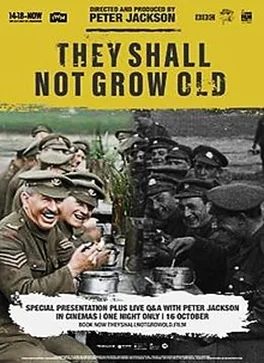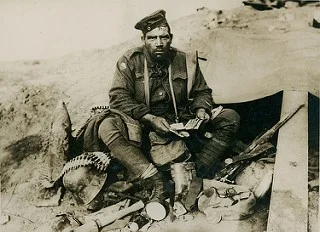Movie: They Shall Not Grow Old - The Power of The Individual Place In A Worldwide Struggle
Image via Wikipedia
‘They Shall Not Grow Old is compelling history for both historians and non-historians.’ Says director Peter Jackson.
In the midst of all the holiday superhero movies, re-boots, re-makes and comic book homages, there is a film that is a bright surprise and a truly moving experience. Peter Jackson, famed director of The Lovely Bones, the Hobbit and The Lord of The Rings has upped his game with an extraordinary documentary, They Shall Not Grow Old. It’s a tribute to British soldiers of World War I, featuring extraordinary footage of their lives on the battlefields, of what was then called the Great War. Much of the historical footage has not been seen before. Presented in both 2D and 3D formats, the film is part of the recognition of the centennial of the armistice, part of the “14-18 NOW” recognition of this important anniversary.
This documentary was culled from 100 hours of vintage film from the archives of the BBC and London’s Imperial War Museum. It is a compelling and fascinating film that breathes life into the men and boys who were fighting for their country in the “war to end all wars.” From the fortification of fox holes, the heart pounding terror of gas attacks, to the inevitable casualties, disease and loss of life, the footage is amazing. Many of the details are repulsive, with uncensored views of the unsanitary conditions and horrible human destruction. And some details were unexpected, like the friendly interface and treatment of captured German soldiers by the British – was it really a more enlightened and civilized time? I like to think that my maternal Grandfather, Doughboy Ivan Hacker of Indiana USA, was represented in this part of the documentary with positive interactions between opposing sides when hostages were taken.
WW1 Group of Soldiers mug for the camera. Via Flickr.com
But the film footage is just half the story. The documentary is replete with dozens of interviews with veterans, who serve to focus in on the experiences that we are witnessing on film. These interviews are also totally authentic – WW1 veterans voices recorded over 60 years ago, sharing their war memories with the BBC, during the years that most of those who served in the Great War were dying off. Jackson researched over 600 hours of audio research for the film.
One of the other great strengths of the documentary is that the project is part of a larger film preservation effort. This is a key element for my fascination with the film, as Jackson and his teams of technicians have rehabilitated and re-furbished the century old clips, protecting its historical imprint and bestowing an amazing impression of the times on a 21st century audience. Preserving the film was one of the priorities of the production company, Jackson explained after the film (in an additional ‘how the documentary was made,’ documentary). The refurbished film has color and clarity, and even dialogue added where possible (lip readers were used to ascertain conversations and speeches. Jackson's direction and editing efforts are extraordinary, moving between the BBC footage to period drawings that depicted the heat of battle of WW1. At points it becomes too much, a quickly paced assault on the senses. It will take another viewing or two to fully appreciate it all). The amazing color enhancement and renewed clarity of the film creates a dreamlike experience at times.
But don’t call this process “colorization,” the scourge of the 1980’s and Ted Turner, who used a primitive colorization process in the attempt to re-market classic films like Casablanca (because many people would supposedly not watch because they were black and white). The color process in those days was inconsistent, unreal and incomplete, called by Roger Ebert as an “ugly overcoat of "colors" slapped on top of the blacks and white and grays…an imitation of color,” It was fraudulent and ruined the director’s and cinemaphotographer’s work.
No, this highly advanced film restoration brings the incredible footage and highlights the remarkable young faces of the men and boys on the line. Of course W1 is already a compelling story, a monumental and tumultuous period in world history; add this authentic immersion deep into its shocking world, and the inescapable piercing faces of the young men that jump out at you in disbelief. These young men are suffering, many appear to be in a stupor as they march by the movie camera and crew – something most had never seen before in real life. They must wonder why they were being filmed and who these people were as they stare at the camera, apparently a state of shock. And yet there are some who smile and mug for the camera, just like people do today when they see a camera, over 100 years later.
WW1 Soldier via Flickr.com



